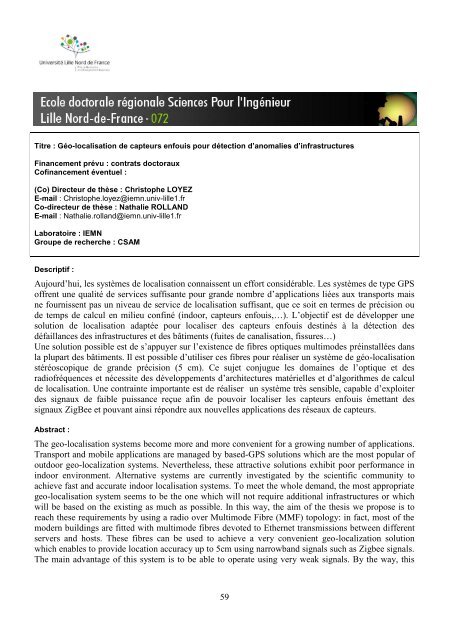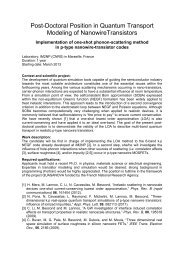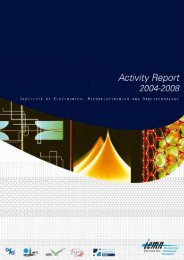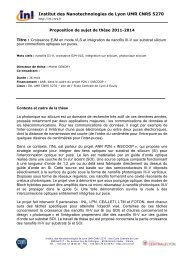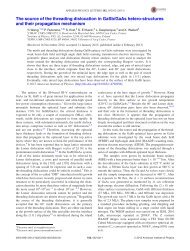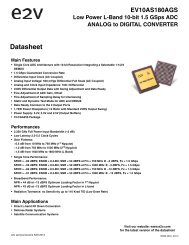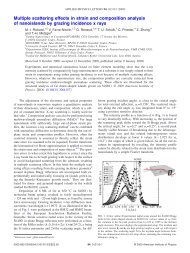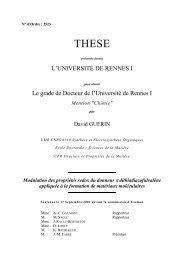Sujet de Doctorats 2013 - IEMN
Sujet de Doctorats 2013 - IEMN
Sujet de Doctorats 2013 - IEMN
- No tags were found...
Create successful ePaper yourself
Turn your PDF publications into a flip-book with our unique Google optimized e-Paper software.
Titre : Géo-localisation <strong>de</strong> capteurs enfouis pour détection d’anomalies d’infrastructuresFinancement prévu : contrats doctorauxCofinancement éventuel :(Co) Directeur <strong>de</strong> thèse : Christophe LOYEZE-mail : Christophe.loyez@iemn.univ-lille1.frCo-directeur <strong>de</strong> thèse : Nathalie ROLLANDE-mail : Nathalie.rolland@iemn.univ-lille1.frLaboratoire : <strong>IEMN</strong>Groupe <strong>de</strong> recherche : CSAMDescriptif :Aujourd’hui, les systèmes <strong>de</strong> localisation connaissent un effort considérable. Les systèmes <strong>de</strong> type GPSoffrent une qualité <strong>de</strong> services suffisante pour gran<strong>de</strong> nombre d’applications liées aux transports maisne fournissent pas un niveau <strong>de</strong> service <strong>de</strong> localisation suffisant, que ce soit en termes <strong>de</strong> précision ou<strong>de</strong> temps <strong>de</strong> calcul en milieu confiné (indoor, capteurs enfouis,…). L’objectif est <strong>de</strong> développer unesolution <strong>de</strong> localisation adaptée pour localiser <strong>de</strong>s capteurs enfouis <strong>de</strong>stinés à la détection <strong>de</strong>sdéfaillances <strong>de</strong>s infrastructures et <strong>de</strong>s bâtiments (fuites <strong>de</strong> canalisation, fissures…)Une solution possible est <strong>de</strong> s’appuyer sur l’existence <strong>de</strong> fibres optiques multimo<strong>de</strong>s préinstallées dansla plupart <strong>de</strong>s bâtiments. Il est possible d’utiliser ces fibres pour réaliser un système <strong>de</strong> géo-localisationstéréoscopique <strong>de</strong> gran<strong>de</strong> précision (5 cm). Ce sujet conjugue les domaines <strong>de</strong> l’optique et <strong>de</strong>sradiofréquences et nécessite <strong>de</strong>s développements d’architectures matérielles et d’algorithmes <strong>de</strong> calcul<strong>de</strong> localisation. Une contrainte importante est <strong>de</strong> réaliser un système très sensible, capable d’exploiter<strong>de</strong>s signaux <strong>de</strong> faible puissance reçue afin <strong>de</strong> pouvoir localiser les capteurs enfouis émettant <strong>de</strong>ssignaux ZigBee et pouvant ainsi répondre aux nouvelles applications <strong>de</strong>s réseaux <strong>de</strong> capteurs.Abstract :The geo-localisation systems become more and more convenient for a growing number of applications.Transport and mobile applications are managed by based-GPS solutions which are the most popular ofoutdoor geo-localization systems. Nevertheless, these attractive solutions exhibit poor performance inindoor environment. Alternative systems are currently investigated by the scientific community toachieve fast and accurate indoor localisation systems. To meet the whole <strong>de</strong>mand, the most appropriategeo-localisation system seems to be the one which will not require additional infrastructures or whichwill be based on the existing as much as possible. In this way, the aim of the thesis we propose is toreach these requirements by using a radio over Multimo<strong>de</strong> Fibre (MMF) topology: in fact, most of themo<strong>de</strong>rn buildings are fitted with multimo<strong>de</strong> fibres <strong>de</strong>voted to Ethernet transmissions between differentservers and hosts. These fibres can be used to achieve a very convenient geo-localization solutionwhich enables to provi<strong>de</strong> location accuracy up to 5cm using narrowband signals such as Zigbee signals.The main advantage of this system is to be able to operate using very weak signals. By the way, this59


